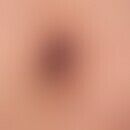Synonym(s)
HistoryThis section has been translated automatically.
Fordyce 1896
DefinitionThis section has been translated automatically.
Circumscribed vascular ectasia(angiokeratoma) on the scrotum, vulva, more rarely also on the glans penis (there disseminated or strung in the area of the corona glandis).
You might also be interested in
EtiopathogenesisThis section has been translated automatically.
ManifestationThis section has been translated automatically.
LocalizationThis section has been translated automatically.
Scrotum, vulva, glans penis
ClinicThis section has been translated automatically.
Isolated or multiple, mostly disseminated, but also grouped, pinhead to lenticular, first light, then blue-red papules or vesicles with mostly smooth, occasionally scaly or verrucous, sometimes eroded surface. No significant growth tendency. Occasional wetting or bleeding possible. Otherwise no symptoms.
HistologyThis section has been translated automatically.
DiagnosisThis section has been translated automatically.
Clinical picture is diagnostic. Histological confirmation if necessary.
Differential diagnosisThis section has been translated automatically.
TherapyThis section has been translated automatically.
Note(s)This section has been translated automatically.
The term "angiokeratoma" is not applicable in the context of this clinical picture and is not comparable to other diseases which are also called "angiokeratomas" (e.g. Angiokeratoma Mibelli, Angiokeratoma circumscriptum), but rather to pure vascular ectasia (Venous lakes) comparable to vascular ectasia in other localisations.
Case report(s)This section has been translated automatically.
angiokeratomas of the penis
In a 53-year-old, otherwise healthy patient, an increasing number of symptom-free, soft, completely painless red to red-blue papules have appeared for several years. The surface is smooth, occasionally slightly roughened with fine scales.
Diagnosis: A histological examination was not performed because of the clear clinical findings.
Diagnosis: Angiokeratomas of the penis
Therapy: The patient should be informed in detail about the harmlessness of the findings. A therapy is not necessary.
LiteratureThis section has been translated automatically.
- Bechara FG, Altmeyer P, Jansen T (2004) Unilateral angiokeratoma scroti: a rare manifestation of a vascular tumor. J Dermatol 31: 39-41
- Fordyce JA (1896) Angiokeratoma of the scrotum. J Cutan Genitourin Dis 14: 81-87
- Jansen T, Bechara FG, Stucker M, Altmeyer P (2002) Angiokeratoma of the scrotum (Fordyce type) associated with angiokeratoma of the oral cavity. Acta Derm Venereol 82: 208-210
- Miller C, James WD (2002) Angiokeratoma of Fordyce as a cause of red scrotum. Cutis 69: 50-51
Outgoing links (9)
Angiokeratoma circumscriptum; Angiokeratomas (overview); Argon laser; Excision; Fabry's disease; Kaposi's sarcoma (overview); Laser; Mibelli's angiokeratoma; Papel;Disclaimer
Please ask your physician for a reliable diagnosis. This website is only meant as a reference.













